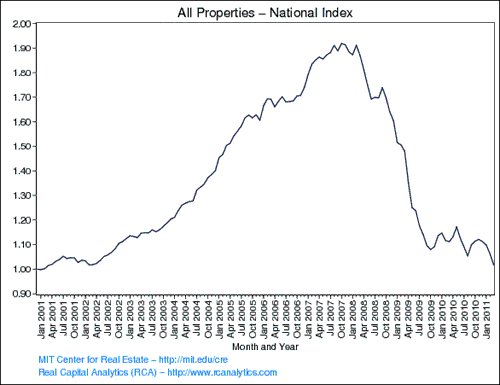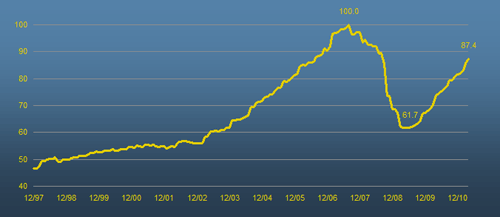This might seem like a simple question. But it is not.
The Moodys/REAL Commercial Property Price Index (CPPI), produced at MIT, says they are still falling:

Green Street’s Commerical Property Price Index says they are rising:

Which one is correct matters. If Green Street is right, and prices are only 12.6 percent off peak, then commercial properties by-and-large have equity (loan-to-value ratios rarely exceeded 80 percent on commericial properties). If MIT is right, we are still in deep trouble.
Both sources do a good job explaining their methods. For MIT:
The Moodys/REAL commercial property index (CPPI) is a periodic same-property round-trip investment price change index of the U.S. commercial investment property market based on data from MIT Center for Real Estate industry partner Real Capital Analytics, Inc (RCA). The methodology for index construction has been developed by the MIT/CRE through a project undertaken in cooperation with a consortium of firms including RCA and Real Estate Analytics, LLC (REAL). The index has been developed with the objective of supporting the trading of commercial property price derivatives. The index is designed to track same-property realized round-trip price changes based purely on the documented prices in completed, contemporary property transactions. The index uses no appraisal valuations. The methodology employed to construct the index is a repeat-sales regression (RSR), as described in detail in Geltner & Pollakowski (2007). The data source for the index is described in detail in a white paper available from RCA.
The set of indices developed so far includes a national all-property index at the monthly frequency, national quarterly indices for each of the four major property type sectors (office, apartment, industrial, retail), selected annual-frequency indices for specific property sectors in specific metropolitan areas, and primary markets quarterly indices for the top 10 metropolitan areas in the major property types. The annual indices are produced in four versions, beginning in January, April, July, and October of each year. These are respectively named the calendar year (CY) index, the fiscal year ending March (FYM) index, the fiscal year ending June (FYJ) index and the fiscal year ending September (FYS) index.
The RCA Database
The commercial property index is based on the RCA database which attempts to collect, on a timely basis, price information for every commercial property transaction in the U.S. over $2,500,000 in value. This represents one of the most extensive and intensively documented national databases of commercial property prices ever developed in the U.S.
The Moodys/REAL CPPI and the TBI
The Moodys/REAL CPPI index is a complementary information product to the transaction based index (TBI) also published on the MIT/CRE web site. Both the CPPI and the TBI are based purely on transaction price data. The TBI is based on NCREIF property sales prices data, while the CPPI is based on RCA sales prices data. Thus, the TBI is based on a smaller population of more purely institutionally held properties. The TBI is based on a hedonic regression methodology whereas the CPPI is constructed with a repeat-sales methodology. The TBI is published with history going back to 1984 but only at the quarterly frequency, and only at the national level (for the four major property types), whereas the CPPI includes monthly and annual frequencies and more geographic regional break outs. The CPPI is a variable-liquidity price-change (appreciation return) index, while the TBI includes total return and demand and supply-side indexes.
For Green Street:
Green Street’s Commercial Property Price Index is a time series of unleveraged U.S. commercial property values that captures the prices at which commercial real estate transactions are currently being negotiated and contracted.
Two features that differentiate this index are its timeliness and its ability to capture changes in the aggregate value of the commercial property sector.
• Timeliness: Other indices are based on closed transactions, and therefore convey info about market prices from several months earlier. Also, the Green Street index value for a given month is released within days of monthend, whereas other indices have a sizeable lag. As shown below, the Green Street index spots inflection points earlier than other indices.
• Weighting: This index is weighted by asset value within each property sector, and therefore it provides a gauge of changes in aggregate values. Most other indices are equally weighted.
So the big differences are: (1) MIT looks only at transactions, whereas Green Street looks at current negotiations; (2) MIT’s valuation model gives equal weight to all properties, while Green Street’s valuation gives greater weight to expensive properties than to cheaper properties; and (3) MIT has a much broader sample, because REITs would rarely buy properties as inexpensive as $2.5 million.
So which index is correct? It all depends on context. While I would be a little leary of using “negotiated price” as an indicator of value (as opposed to closed transactions), the timeliness of Green Street’s data does give it an advantage. For REIT’s trying to determine strategy, the Green Street index is probably better. For banks making loans to smaller properties–or for individual investors thinking of buying small office buildings–the MIT index is more relevant.
- Bulenox: Get 45% to 91% OFF ... Use Discount Code: UNO
- Risk Our Money Not Yours | Get 50% to 90% OFF ... Use Discount Code: MMBVBKSM
Disclaimer: This page contains affiliate links. If you choose to make a purchase after clicking a link, we may receive a commission at no additional cost to you. Thank you for your support!



Leave a Reply